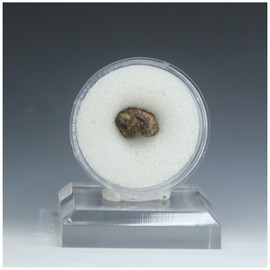Dynamic Kimberlite Big Hole South Africa XRF Included [53012]
Brand : Sciencemall-USA
- SKU:
- JPT-53012
- Condition:
- New
- Availability:
- Usually ships in 24 hours.
- Weight:
- 1.00 LBS
- Minimum Purchase:
- 1 unit
- Maximum Purchase:
- 1 unit
- Shipping:
- Calculated at Checkout
This impressive kimberlite rock specimen is from the famous, now closed "Big Hole" open-pit Kimberley mine in South Africa. Renowned for being the second-largest hole ever excavated by hand, this magnificent specimen holds historical significance. From 1871 to 1914, a remarkable 50,000 miners tirelessly dug the hole using only picks and shovels, unearthing an incredible 6,000 pounds of diamonds. This rock specimen serves as a tangible reminder of the remarkable mining feats accomplished at that time.
Kimberlite is an igneous, often diamond-bearing rock named after the town of Kimberley, South Africa. The original frontier town was called New Rush, and homes and businesses quickly arose from the barren landscape. In June 1873, New Rush was renamed Kimberley.
The 1869 discovery of the Star of South Africa Diamond (an 83.5-carat - 16.70 g) spawned a diamond rush to the area, which resulted in the open-pit mine called the "Big Hole." The morphology of kimberlite pipes and the classical carrot-shaped brecciated fragments seen in them result from explosive diatreme volcanism from deep mantle-derived sources. Volcanic explosions produced vertical columns of rock that rose from deep magma reservoirs.
Ilmenite, chromite, & garnet can typically found in this kimberlite. Exquisite olivine crystals can be seen in this rock specimen. Olivine is one of the earliest minerals to crystallize in kimberlite magmas.
Size: 57mm L X 53mm W X 12mm D. Weight: 87.6 grams. Polished flat front and back. Light coating, removed easily with soapy water.
This material was legally obtained in a trade with a scientific institution. Note: Only a few left.
Ships with information, Certificate of Authenticity, tag and tag stand. Photo cube not included. XRF included.
This kimberlite is from the famous "Big Hole," and that is what makes it an important addition to a geological collection.









![Komatiite from the Pioneer complex [68947] Weltevreden Formation, Barberton, South Africa shown on an acrylic riser. Komatiite from the Pioneer complex [68947] Weltevreden Formation, Barberton, South Africa shown on an acrylic riser.](https://cdn11.bigcommerce.com/s-ijipkdz2cc/images/stencil/270x270/products/134/1642/Komatiite-Barberton-South-Africa-68947-main__44547.1697036156.jpg?c=1)